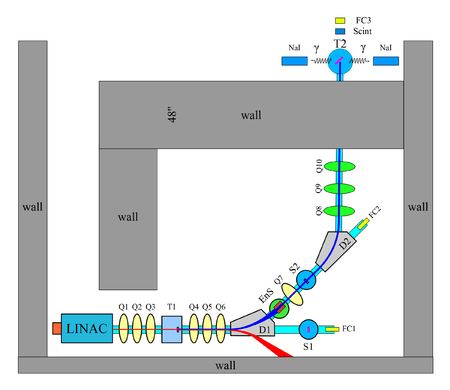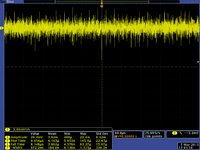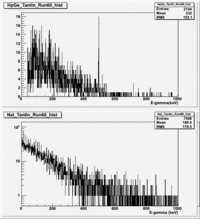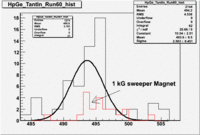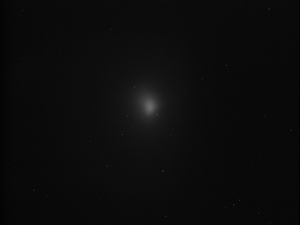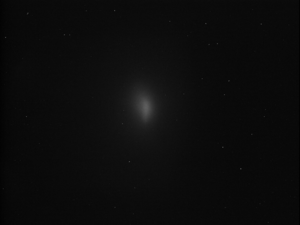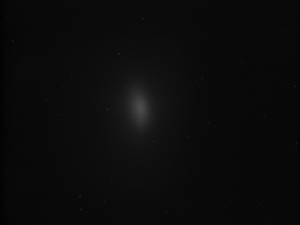Sadiq Proposal Defense
I propose a measurement of the positron production efficiency using a quad triple collection system. The quad triplet collection system was proposed by ... A previous experiment at the IAC observed positrons. I have optimized a beam line to improve that experiment and will quantify the positron production efficiency.
Abstract
I propose to use an quadrupole triplet system to measure positron production efficiency at the High Rep Rate Linac (HRRL) at Idaho State University's (ISU) Idaho Accelerator Center (IAC). In the previous experiment conducted at IAC, we observed positrons. Dr. G. Stancari proposed to use quadrupole triplet system to collect positrons. Positrons produced at the target has wide spread of momentum and divergence. Using triplet system we can focus positron beam, thus increase our efficiency. HRRL cavity is relocated and new beamline is setup to use quadrupole triplet system. I also intend to perform simulations to study optimum beamline settings before running experiment. I want to use NaI detectors to measure and quantify the positrons.
Introduction
New Beamline
I propose a measurement of the positron production efficiency using the High Repetition Rate Linac (HRRL) located at the Beam Lab of the Physics Department, at Idaho State University (ISU). HRRL is a S-band electron linac located in the Beam Lab of the Physics Department at Idaho State University (ISU). It is one the 15 small size linacs dedicated for nuclear application operated by the IAC. HRRL can provide electron beam with energies between 3 MeV and 16 MeV, and Maximum repetition rate of 1 kHz. HRRL beamline had recently been reconfigured to generate and collect positrons, while it still can provide electron beam with improved quality. More details about HRRL is shown in Table 1.
| Beam Energy | Max Peak Current | Repetition Rate | Max Pulse Length |
| 16 MeV | 80 mA | 1 kHz | 250 ns (FWHM) |
New beamlien first designed by Dr. G. Stancari, it uses quadrupole triplet to collect positrons. The design further optimized by Dr. Y Kim, and J.Ellis. Beamline is constructed, as shown in Fig.1, in the Beam Lab which is located in the basement of ISU physical sciences complex. Beam Lab is divided into two parts by a L-shaped cement wall. The accelerator cell houses the cavity and magntic elements needed to transport electrons to an experimental cell. The experimental cell is located in an adjacent room to the accelerator cell. The HRRL beamline was reconfigured into an achromat by moving the accelerator cavity to accomdate two dipoles and a system of quadrupole magnets optimized for collecting positrons.
In the new beamline, the electron beam exits the HRRL cavity and passes through first the set of quadruple triplet magnets which will be used to focus the electron beam onto the positron target. Positrons produced from the positron target will be collected by second set of quadruple triplet that will be optimized to collect positrons. The first dipole magnet bends the positrons or electrons, depending on the polarity setting, by 45 degrees towards a second dipole magnet. The second dipole will bend the beam another 45 degrees, thus completes a 90 degree bend. A third quadruple triplet will be used focus the e-/e+ beam, as users desired.
| Item | Description |
| T1 | Positron target |
| T2 | Annihilation target |
| EnS | Energy Slit |
| FC1, FC2 | Faraday Cups |
| Q1,...Q10 | Quadrupoles |
| D1, D2 | Dipoles |
| NaI | NaI Detecotrs |
| OTR | OTR screen |
| YAG | YAG screen |
Positron annihilation target at the end of the beamline is set up for the measurement of the positrons created. When positrons annihilated at the positron target, two 511 keV photons will be created. Photons go back to back, and isotropically. The two detectors placed closely to the to the target, will used to detect these 511 keV photons.
Earlier measurements
Earlier measurements were conducted at Idaho Accelerator Center of ISU, May of 2008. Setup are shown in Fig.2. Accelerator was operated at 300 Hz repetition rate. Positrons at the end of the linac annihilated in the Ta target, 511 keV photons were observed in both HpGe and NaI detectors. In the Fig.3, the spectrum was taken over 600 seconds.
| Run # | MPA file name | W | Ta | Description |
| 60 | NaI060.mpa | IN | In | Dipole at 3 MeV (1.44 on Pot), 300 Hz rep rate, (802 set to 15.7 kV, 276 counts at 500 keV, Live=600 seconds, grid = 1.64, Gun = 3 kV. |
| Item | Description |
| Tantalum Foil | 6 mm thick 20 mm x 20 mm area |
| Tungsten Foil | 2 mm thick 20 mm x 20 mm area |
| Phosphorus Flag | 1 mil aluminum backing |
| Media:HpGe_Crystal_GEM-60195-Plus-P.pdf | 81.3mm Diameter, 55.5mm Length |
| NaI detector |
Preparation for the Positron Production Experiment
HRRL Emittance measurements
Emittance is an important parameter in accelerator physics. If emittance with twiss parameters are given at the exit of the gun, we will be able to calculate beam size and divergence any point after the exit of the gun. Knowing the beam size and beam divergence on the positron target will greatly help us study the process of creating positron. Emittance with twiss parameters are also key parameters for any accelerator simulations. Also, energy and energy spread of the beam will be measured in the emittance measurement.
Optical Transition Radiation (OTR) emittance measurement was carried out on HRRL on March of 2011 with a 10 thick aluminium screen. Transition radiation is emitted when a charge moving at a constant velocity cross a boundary between two materials with different dielectric constant. Emitted photons are observed on the camera give us information about the size of the electron beam.
We used quadrupole scanning method to measure emittance. In this method we turn off all the quads except one we use for scanning, we change quad current and we observe beam spot changes. In the Fig.5-7 are shown beam spots for quadrupole coil currents.
I used the MATLAB to analyze the data. The results shows that:
Positron Detection using NaI crystal
To detect positrons created, I want a put Ta target at the end of 90 degree beamline as my Annihilation. When positrons hit W-target, 511 keV photons will be created. I want to use NaI detectors to detect these 511 keV photons.
I acquired some NaI crystals from Idaho Accelerator Center (IAC). I built our own PMT bases for them, since their own bases not working properly. I modified the design of model PA-14 from Saint-Gobain crystals & detectors ltd. Now these detectors are tested and calibrated, and ready to use for the measurement.
Even though now the 511 keV peak seems to be very wide and resolution is low, But this can be improved by doing coincidence of two detectors in the experiment.
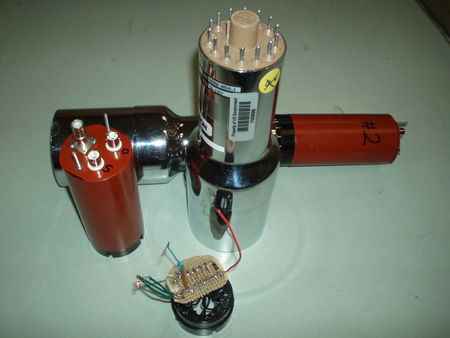 |
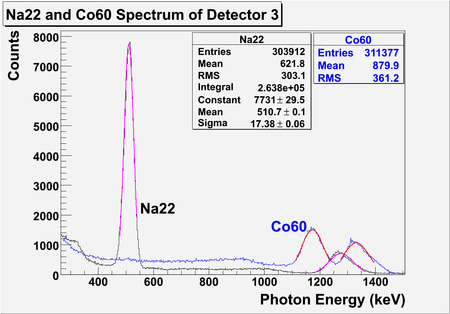
|
| Fig. The NaI detector and base built. | Fig. Detector 3 calibrated Spectrum. |
| NaI detector |
Future Plan
Positron Target
A tungsten target will be placed in the space between 1st and 2nd triplet. The tungsten target will be placed inside a big chamber.
Emittance Tests with Energy Scan
I want to do emittance test with precise energy scan. I remapped dipole magnet for more precise energy scan. This will also improve our emittance measurement.
Positron Yield
I will insert the first tungsten target and create positrons. I am expecting to collect part these positrons and transport them down the second tungsten target at the end of the 90 degree beamline. By doing these, 511 keV photons will be created and I want to detect them by our NaI detectors.
References
<references/>
